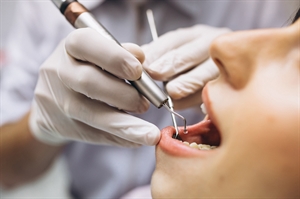All Categories
Featured
Table of Contents
In Grand Forks, ND, Triston Pace and Britney Thomas Learned About Things To Do Around Frederick Md
Why Is Dental Care Important? Dental care is very important to everyone. It is a way that you can maintain a healthy oral health and to keep your teeth from becoming decayed or infected. Here are some reasons why it is important to get regular dental checkups. When you are younger, your teeth can be very delicate so proper oral hygiene is essential. This means that you should brush and floss every day. It is also a good idea to visit your dentist at least once a year for checkups and cleanings. Your dentist will be able to take a look at your teeth and tell you what they think needs to be done. The first step in proper teeth cleaning and maintenance is a professional cleaning. It is important to note that cleaning is not always performed by a dentist. Some other factors that might require a professional cleaning include root canal treatments, fillings, crowns and dental implants. If a dentist performs the cleaning on an individual's own, it may be very difficult to maintain the quality of that individual's teeth and gums. The dentist will use an instrument known as a dental trying to clean the teeth and gums. There are other types of problems as well such as tooth decay and gum disease. Gum disease can result in gingivitis. If you have gingivitis and you neglect your teeth, it can cause gum disease. It is important to see your dentist on a regular basis for these types of problems. When visiting a dentist's office for this type of procedure, the patient is advised to follow the doctor's recommendation regarding how often he or she should clean their teeth and gums. Some professionals believe the best way to maintain proper dental hygiene is through daily brushing, while others prefer to practice twice or three times a day. Another common type of problem is gum disease. Your dentist can diagnose this condition by taking a close look at your mouth. They will be able to tell you what needs to be done for your condition and if you need dental treatment or not. You should always remember that oral health is very important. You want your mouth to be free of bacteria and other things that can cause infections. You should always brush, floss and use a fluoride mouthwash to keep your mouth healthy. Dental hygienists perform the actual cleaning process when the patient enters the dentist's office and performs their oral care. They are trained in using the equipment and the dentist cleans the teeth and removes plaque and bacteria from the teeth. When you eat foods that you should not, your teeth may become stained. These stains can be very difficult to remove. If you ignore the stain, the food may build up on your teeth and the stain will begin to change your appearance. One of the most common dental problems is periodontitis. This disease is a result of plaque buildup on the teeth. Over time, plaque accumulates and forms into tartar. This can become a serious problem because it can eat away at the gums and cause the gums to recede. This condition can also lead to tooth loss. Periodontal disease can also be a result of tooth decay. This type of disease causes periodontal pockets, which are pockets in the gums and teeth where bacteria and other things can form. If the bacteria and other organisms are not removed, the pockets can fill up and cause the gums to weaken. It can be very important to see your dentist for these types of oral problems. You do not want to wait to see a specialist. Most people have their problems fixed in the first visit, but they may need to see a specialist for more complicated conditions. Dental care is extremely important. You never know when you may need it. Your dentist can help you get the oral problems you need and prevent them from happening. Once you get better, you will be able to keep your teeth healthy and your smile beautiful for years to come.
City in Maryland, United StatesFrederick, MarylandCity of FrederickBridge on Carroll CreekMotto( s): "The City of Clustered Spires" Location within the State of MarylandShow map of MarylandFrederick (the United States) Show map of the United StatesCoordinates: Collaborates: United States Founded1745Government MayorMichael O'Connor (D-MD) Board of AldermenKelly Russell (D-MD) Ben MacShane (D-MD) Derek Shackleford (D-MD) Donna Kuzemchak (D-MD) Roger Wilson (D-MD) Location City24.
28 km2) Land23. 95 sq mi (62. 02 km2) Water0. 10 sq mi (0. 26 km2) Elevation302 feet (92 m) Population City65,239 Estimate 72,244 Density3,016. 95/sq mi (1,164. 84/km2) Urban141,576 (US: 230th)UTC5 (EST) Summertime (DST)UTC4 (EDT) 21701-21709301, 24024-30325GNIS feature ID0584497I-70, I-270, United States 15, United States 40, US 340, MD 80, MD 144, MD 355Site Frederick is a city in, and the county seat, of Frederick County, Maryland.
Frederick has long been an essential crossroads, located at the intersection of a significant northsouth Indian trail and eastwest paths to the Chesapeake Bay, both at Baltimore and what ended up being Washington, D.C. and throughout the Appalachian mountains to the Ohio River watershed. It is a part of the Washington-Arlington-Alexandria, DC-VA-MD-WV Metropolitan Statistical Area, which becomes part of a higher Washington-Baltimore-Arlington, DC-MD-VA-WV-PA Combined Statistical Area.
Frederick is house to Frederick Municipal Airport (IATA: FDK), which accommodates general air travel, and to the county's largest employer U.S. Army's Fort Detrick bioscience/communications research study setup. Found where Catoctin Mountain (the easternmost ridge of the Blue Ridge mountains) fulfills the rolling hills of the Piedmont area, the Frederick area became a crossroads even before European explorers and traders arrived.
This became referred to as the Monocacy Trail or perhaps the Great Indian Warpath, with some tourists continuing southward through the "Excellent Appalachian Valley" (Shenandoah Valley, etc.) to the western Piedmont in North Carolina, or traveling down other watersheds in Virginia toward the Chesapeake Bay, such as those of the Rappahannock, James and York Rivers.

Founded prior to 1730, when the Indian trail ended up being a wagon road, Monocacy was deserted prior to the American Revolutionary War, maybe due to the river's regular flooding or hostilities predating the French and Indian War, or merely Frederick's much better place with easier access to the Potomac River near its confluence with the Monocacy.
Three years previously, All Saints Church had been founded on a hill near a warehouse/trading post. Sources disagree as to which Frederick the town was called for, however the likeliest candidates are Frederick Calvert, sixth Baron Baltimore (among the proprietors of Maryland), Frederick Louis, Prince of Wales, and Frederick "The Great" of Prussia.
Frederick Town (now Frederick) was made the county seat of Frederick County. The county originally reached the Appalachian mountains (locations additional west being contested between the nests of Virginia and Pennsylvania until 1789). The current town's very first house was developed by a young German Reformed schoolmaster from the Rhineland Palatinate called Johann Thomas Schley (died 1790), who led a celebration of immigrants (including his better half, Maria Von Winz) to the Maryland colony.
In Bonita Springs, FL, Areli Mercado and Amiya Davis Learned About Events In Frederick Md Today
Schley's settlers also founded a German Reformed Church (today understood as Evangelical Reformed Church, and part of the UCC). Most likely the earliest home still standing in Frederick today is Schifferstadt, integrated in 1756 by German settler Joseph Brunner and now the Schifferstadt Architectural Museum. Schley's group was amongst the lots of Pennsylvania Dutch (ethnic Germans) (as well as Scots-Irish and French and later Irish) who migrated south and westward in the late-18th century.
Another important route continued along the Potomac River from near Frederick, to Hagerstown, where it divided. One branch crossed the Potomac River near Martinsburg, West Virginia and continued down into the Shenandoah valley. The other ongoing west to Cumberland, Maryland and eventually crossed the Appalachian Mountains into the watershed of the Ohio River.
Nevertheless, the British after the Pronouncement of 1763 restricted that westward migration path up until after the American Revolutionary War. Other westward migrants continued south from Frederick to Roanoke along the Great Wagon Road, crossing the Appalachians into Kentucky and Tennessee at the Cumberland Gap near the Virginia/North Carolina border. Other German inhabitants in Frederick were Evangelical Lutherans, led by Rev.
They moved their objective church from Monocacy to what became a big complex a couple of blocks further down Church Street from the Anglicans and the German Reformed Church. Methodist missionary Robert Strawbridge accepted an invite to preach at Frederick town in 1770, and Francis Asbury showed up two years later on, both helping to found a congregation which ended up being Calvary Methodist Church, worshiping in a log structure from 1792 (although superseded by larger buildings in 1841, 1865, 1910 and 1930).
Jean DuBois was appointed in 1792, which became St. John the Evangelist Church (constructed in 1800). To control this crossroads throughout the American Transformation, the British garrisoned a German Hessian regiment in the town; the war (the stone, L-shaped "Hessian Barracks" still stand). All Saints Church, put up 1813, Principal Parish Church till 1855As the county seat for Western Maryland, Frederick not just was an essential market town, however likewise the seat of justice.
Crucial legal representatives who practiced in Frederick included John Hanson, Francis Scott Key and Roger B. Taney. Church Street with All Saints and Reformed Church spires, FrederickFrederick was also known throughout the nineteenth century for its spiritual pluralism, with among its primary roads, Church Street, hosting about a half dozen major churches.


That original colonial building was changed in 1814 by a brick classical revival structure. It still stands today, although the primary worship space has ended up being an even bigger brick gothic church joining it at the back and dealing with Frederick's City Hall (so the parish remains the earliest Episcopal Church in western Maryland).
John the Evangelist, was developed in 1800, then rebuilt in 1837 (across the street) one block north of Church Street on East Second Street, where it still stands along with a school and convent established by the Visitation Sisters. The stone Evangelical Lutheran Church of 1752 was likewise rebuilt and bigger in 1825, then changed by the present twin-spired structure in 1852.
In Portsmouth, VA, Lindsay Mccall and Lucia Lang Learned About Frederick This Weekend
It ended up being an African-American congregation in 1864, renamed Asbury Methodist Episcopal Church in 1870, and built its existing structure on All Saints Street in 1921. Together, these churches controlled the town, set against the background of the first ridge of the Appalachians, Catoctin Mountain. The abolitionist poet John Greenleaf Whittier later on commemorated this view of Frederick in his poem to Barbara Fritchie: "The clustered spires of Frederick stand/ Green-walled by the hills of Maryland." When U.S.
Louis (ultimately constructed to Vandalia, then the state capital of Illinois), the "National Pike" went through Frederick along Patrick Street. (This later became U.S. Path 40.) Frederick's Jacob Engelbrecht referred Jefferson in 1824 (getting a transcribed psalm in return), and kept a journal from 1819-1878 which stays a crucial first-hand account of 19th century life from its perspective on the National Roadway.
Church Street by a local medical professional to prevent the city from extending Record Street south through his land to fulfill West Patrick Street. Frederick also ended up being one of the brand-new country's leading mining counties in the early 19th century. It exported gold, copper, limestone, marble, iron and other minerals. As early as the American Revolution, Catoctin Heating system near Thurmont became crucial for iron production.
Frederick had simple access to the Chesapeake and Ohio Canal, which began operations in 1831 and continued hauling freight up until 1924. Also in 1831, the Baltimore and Ohio Railway (B&O) finished its Frederick Branch line from the Frederick (or Monocacy) Junction off the primary Western Line from Baltimore to Harpers Ferryboat, Cumberland, and the Ohio River.
Louis by the 1850s. Confederate troops marching south on North Market Street throughout the Civil War Frederick ended up being Maryland's capital city briefly in 1861, as the legislature moved from Annapolis to vote on the secession concern. President Lincoln apprehended numerous members, and the assembly was unable to convene a quorum to vote on secession.
Servants likewise gotten away from or through Frederick (since Maryland was still a "slave state" although an unseceded border state) to sign up with the Union forces, work versus the Confederacy and look for freedom. During the Maryland projects, both Union and Confederate troops marched through the city. Frederick also hosted several hospitals to nurse the injured from those battles, as is associated in the National Museum of Civil War Medicine on East Patrick Street.
Union Major General Jesse L. Reno's IX Corps followed Jackson's males through the city a few days later on the way to the Battle of South Mountain, where Reno passed away. The websites of the fights are due west of the city along the National Road, west of Burkittsville. Confederate soldiers under Jackson and Walker unsuccessfully attempted to stop the Federal army's westward advance into the Cumberland Valley and towards Sharpsburg.
The 1889 memorial celebrating Major General Reno and the Union soldiers of his IX Corps is on Reno Monument Roadway west of Middletown, just listed below the top of Fox's Gap, as is a 1993 memorial to slain Confederate Brig. Gen. Samuel Garland Jr., and the North Carolina troops who held the line.
In 21207, Marcel Navarro and Jerimiah Stuart Learned About Frederick Activities
George McClellan after the Fight of South Mountain and the Battle of Antietam, delivered a brief speech at what was then the B. & O. Railway depot at the present intersection of East All Saints and South Market Streets. A plaque celebrates the speech (at what is today the Frederick Neighborhood Action Firm, a Social Services workplace).
The Army of the Potomac camped around the Possibility Hall home for the a number of days as skirmishers pursued Lee's Confederate Army of Northern Virginia prior to Gettysburg. A big granite rectangle-shaped monument made from one of the boulders at the "Devil's Den" in Gettysburg to the east along the driveway honors the midnight change-of-command.
27 million in 2019 dollars) from residents for not taking down the city on their way to Washington D.C. Union soldiers under Major General Lew Wallace battled a successful delaying action, in what ended up being the last considerable Confederate advance at the Battle of Monocacy, likewise referred to as the "Fight that conserved Washington." The Monocacy National Battlefield lies simply southeast of the city limitations, along the Monocacy River at the B.
Railway junction where two bridges cross the stream - an iron-truss bridge for the railway and a covered wood bridge for the Frederick-Urbana-Georgetown Pike, which was the website of the main battle of July 1864. Some skirmishing occurred further northeast of town at the stone-arched "Jug Bridge" where the National Road crossed the Monocacy; and a weapons barrage took place along the National Road west of town near Red Man's Hill and Prospect Hall estate as the Union troops pulled back eastward.
While Gettysburg National Battlefield of 1863 lies approximately 35 miles (56 km) to the north-northeast. The rebuilded house of Barbara Fritchie stands on West Patrick Street, simply past Carroll Creek direct park. Fritchie, a considerable figure in Maryland history in her own right, is buried in Frederick's Mount Olivet Cemetery.
Roosevelt when they stopped here in 1941 on a cars and truck trip to the presidential retreat, then called "Shangra-La" (now "Camp David") within the Catoctin Mountains near Thurmont. Admiral Winfield Scott Schley (18391911) was born at "Richfields", the estate home of his daddy. He became an essential naval commander of the American fleet on board his flagship and heavy cruiser USS Baltimore in addition to Admiral William T.
Major Henry Schley's kid, Dr. Fairfax Schley, was critical in setting up the Frederick County Agricultural Society and the Great Frederick Fair. Gilmer Schley served as Mayor from 1919 to 1922, and the Schleys stayed one of the town's leading households into the late-20th century. Nathaniel Wilson Schley, a prominent lender, and his better half Mary Margaret Schley assisted organize and raise funds for the yearly Great Frederick Fair, one of the two largest agricultural fairs in the State.
Table of Contents
Latest Posts
1682 Tips For Home Gardening
6190 Better Gardening
935 Great Gardening Ideas
More
Latest Posts
1682 Tips For Home Gardening
6190 Better Gardening
935 Great Gardening Ideas